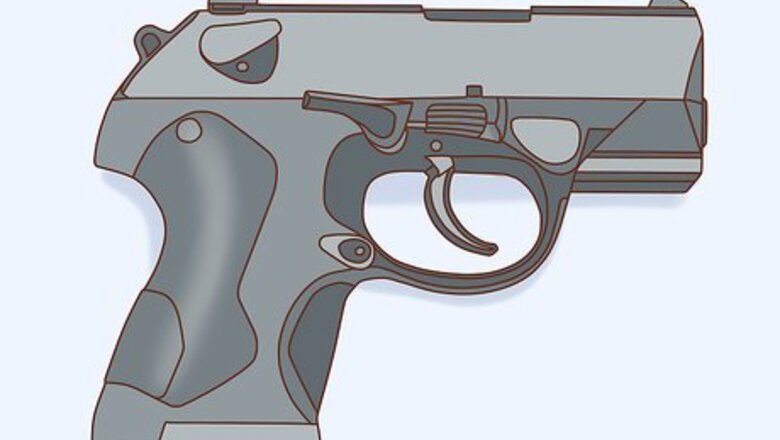
views
Choosing a Gun, Holster, and Clothing
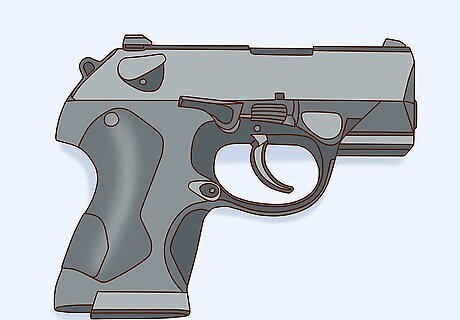
Choose a compact handgun to holster if concealment is important. Most paddle holsters will hold the pistol low and angle it away from your body. As a result, the bottom of the holster and/or firearm has a tendency to peek out from beneath the average shirt or jacket when the holster is used for a long-barreled pistol. If you want to place a long-barreled pistol in a paddle holster and keep it fairly concealed, you’ll probably have to pull your pants up higher on your waist than you’re used to.
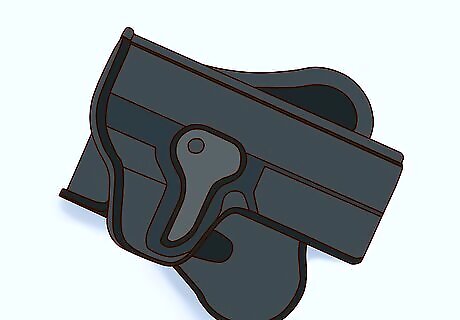
Buy a paddle holster suited to your chosen handgun. Paddle holsters are made by several manufacturers, and come in different sizes and styles to suit different handguns and different needs. When possible, buy a holster that is designed specifically for your chosen handgun. Some paddle holsters are made of leather, while others are made of rigid synthetic materials. The choice typically comes down to fit for your weapon and personal preference.
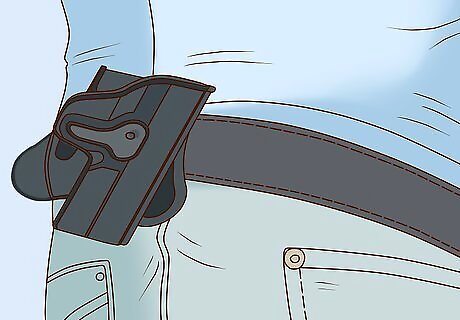
Select a sturdy belt and pants that have a slightly loose fit at the waist. Because the paddle portion of the holster goes inside your waistband, you don’t want to use pants that are super snug at the waist. Otherwise, the paddle may cause discomfort. At the same time, though, the weight of the holster and gun may cause pants that are too loose to droop. So go for pants that fit but give you a little breathing room. Technically, you can wear a paddle holster without a belt, since it doesn’t actually connect to the belt (like belt-style holsters do). However, wearing a belt thickens your waistband, which helps hold the holster in place, and the protruding belt provides a catch point to hold the holster in place when you draw your firearm. Most paddle holsters work best with sturdy leather or synthetic belts that are 1–2 in (2.5–5.1 cm) in width.
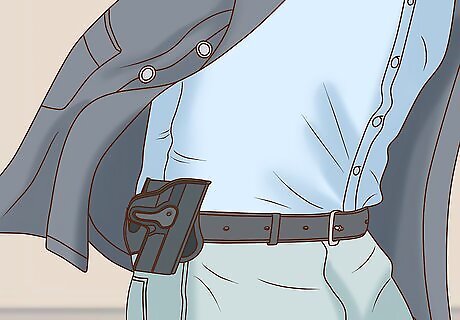
Pick a loose shirt or jacket that will conceal your holster. Since this is an outside the waistband (OWB) holster, you will need to wear a long, loose top (like a blazer or jacket) in order to conceal the pistol and holster. To really hide the holstered weapon effectively, you may need to buy outerwear that is slightly longer and more flowing than normal. Paddle holsters are notoriously bulky due to the way they stick out from your body—this makes them more comfortable to wear, but harder to conceal. Belt-style holsters are less bulky, and inside the waistband (IWB) holsters are the easiest to conceal, but these styles tend to be less comfortable to wear.
Holstering the Pistol and Tucking It in Place
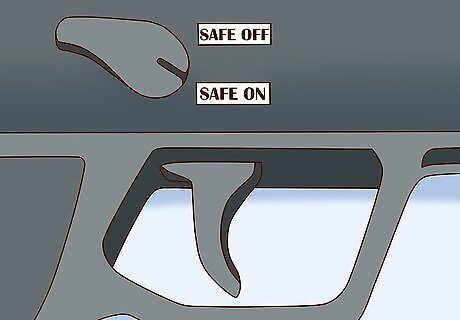
Ensure the handgun’s safety is on before holstering it. Keep safety first and foremost whenever you’re dealing with a firearm. For example, check and recheck that your weapon’s safety is on—if you’re not sure how to do this, consult the manual for your specific weapon. If you intend to carry a loaded pistol, load it according to its instructions before you insert it into the holster. If you do not wish to carry a loaded pistol, make sure that it is not loaded (again, according to its instructions) before you proceed.
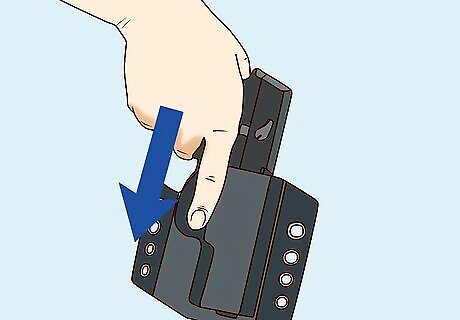
Slide the barrel of the handgun into the holster. Grab the handle of the pistol, but keep your finger off the trigger and along the side of the gun as you handle it. Then, slide the barrel of the pistol into the holster. Press it in firmly until the handgun is seated fully into the body of the holster. When the handgun is seated properly in the holster, you should have full access to the gun’s handle, but not be able to see any of the barrel.
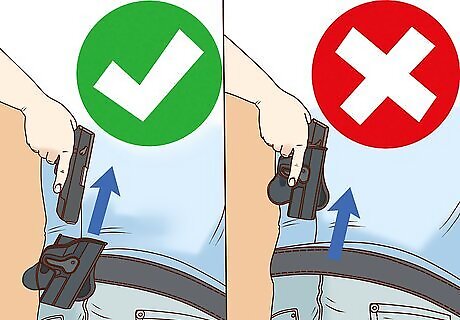
Check the fit to make sure the gun won’t fall out or get stuck. If you pick up the holstered handgun by the handle, the holster should remain in place. When the holster isn’t secured on your waistband, you should have to grasp the holster with your other hand to pull out the pistol. At the same time, though, you shouldn’t have to pull with full force to yank the handgun out of the holster. Otherwise, the holster will pull out of your waistband and stay on the handgun when you draw your weapon. Some paddle holsters are adjustable so you can improve the fit. Otherwise, you may have to find a different handgun and holster combination.
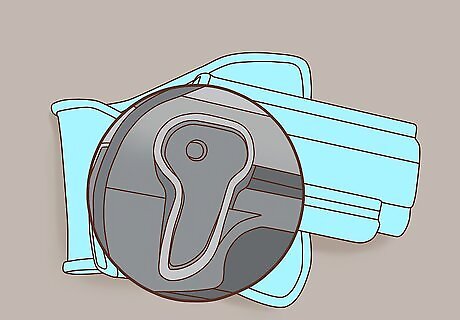
Latch the gun into the holster, if your holster model has a latch. Many models of paddle holsters have button latches, but some do not. If yours does have a latch, snap it in place to further secure the weapon. Holsters without button latches rely on the snug fit of the weapon into the holster to hold the pistol in place. Most latches are made so that you can easily unlatch them with your thumb as you draw the weapon. Check your user’s manual for specific instructions for your model.
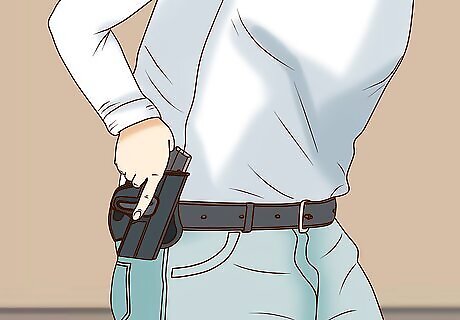
Place the holstered pistol above your waistband, paddle side facing in. Grab the holstered handgun by its handle, with your finger off the trigger. The rigid paddle portion of the holster faces inward toward your body, and will tuck into your waistband. The part of the holster that holds the firearm will hang over the outside of your waistband. Most people like to place the holster right over or just in front of the hip on their dominant side (e.g., right side if you’re right handed). Alternatively, you can place the holster over your weak side hip (so that you draw the weapon across your front with your dominant hand). Some people like to place the holster over their tailbones for added concealment, but you run the risk of hurting yourself if you fall on your back.
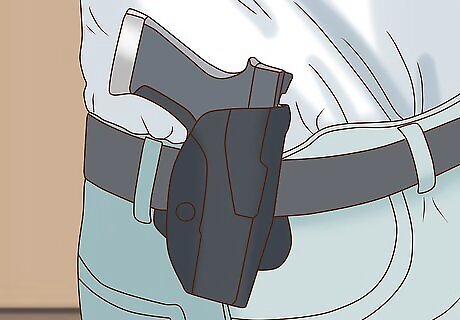
Slide the paddle between your waistband and your underwear. Push the paddle completely over the waistband of your pants, as far downward as it will go. You should feel the tension of the paddle pressing against the waistband of your pants. Some people choose to slide the paddle between the inside of their belt and the outside of their waistband. The holster will remain much more secure, however, if you tuck it inside your waistband and over your belt. If your paddle holster has a security clip or hook along the underside of the paddle, you may hear or feel it click into place once the paddle slides past the seam of your waistband and/or your belt. This security clip helps prevent the holster from sliding out when you draw your weapon.
Adjusting, Using, and Removing the Holster
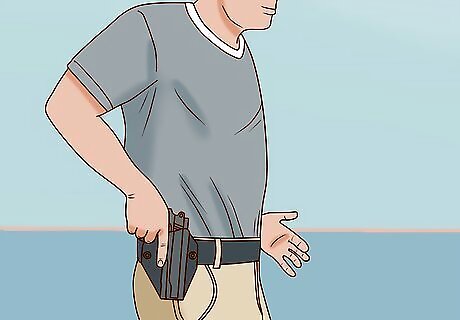
Draw the firearm from the holster with a smooth, secure motion. Grab the handle of the gun with your dominant hand and lift it straight up. Once the barrel has cleared the holster, grip the firearm with both hands and practice aiming the weapon. If the holster has a button latch, you will need to unsnap the latch before removing the gun. Use your thumb to unlatch it as you grab onto the gun handle. The tension and lip on the clip of the paddle should hold the holster in place as you remove the gun, especially if you lift the gun straight up. Keep your finger away from the trigger unless and until you plan to shoot, even when the safety is still on. Make sure that the gun is properly aimed, and that the safety is off, before placing your finger on the trigger and firing the gun.
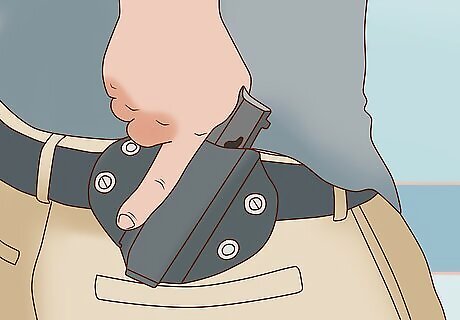
Adjust the positioning of the holster to suit your comfort and needs. Practice drawing the firearm from the holster several more times to check for ease and comfort. You should be able to grasp the handle, undo the button latch (if there is one) with your thumb, and pull out the pistol with a smooth hand and arm motion. Slide the holster forward or back along your waistband if necessary to make drawing easier. Ease of adjustment is one of the major selling points for the paddle holster, especially in comparison to a belt-style holster. Many paddle holsters are made to hold the firearm at a 15-degree forward angle, which makes it easier to draw (this is the standard positioning for the FBI). You can tilt the paddle forward or back slightly to adjust this angle as needed.
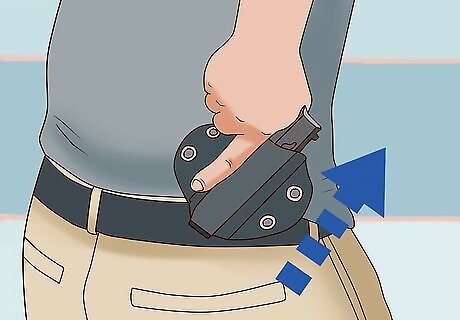
Remove the holster by tilting inward and lifting upward. Keep the gun holstered when you’re ready to take off the holster. Grab the handle of the gun and use it to tilt the top section of the paddle toward your body and away from your waistband—the bottom of the paddle, in turn, will angle outward. With the paddle tilted, lift the weapon and holster up and out of your waistband. If you do not tilt the paddle in this manner, it might get stuck on the waistband or your belt when you try to remove it. The pistol could accidentally come out of the holster this way. Whether you store it in the holster or not, store your firearm in a safe location. You should keep it in a locked cabinet, especially if there are children around.



















Comments
0 comment